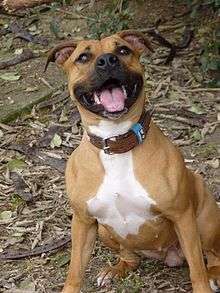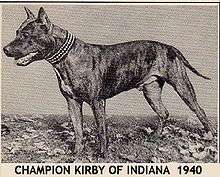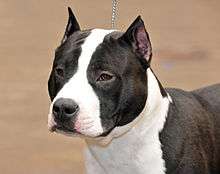American Staffordshire Terrier
 Classic Amstaff female | |||||||||||||||||||||
| Common nicknames |
| ||||||||||||||||||||
|---|---|---|---|---|---|---|---|---|---|---|---|---|---|---|---|---|---|---|---|---|---|
| Origin | United States | ||||||||||||||||||||
| |||||||||||||||||||||
| |||||||||||||||||||||
| Domestic dog (Canis lupus familiaris) | |||||||||||||||||||||
The American Staffordshire Terrier, also known as Amstaff (in the United States) or simply Stafford, is a medium-sized, short-coated American dog breed. Bans: The State of Breed–Specific Legislation |journal=GP-Solo |volume=26 |issue=5 |publisher=American Bar Association |date=July–August 2009 |url=http://www.abanet.org/genpractice/magazine/2009/jul_aug/pitbull.html |accessdate=July 30, 2009}}</ref>[2] In the early part of the twentieth century the breed gained social stature and was accepted by the American Kennel Club in 1936.[3] The name was changed to reflect difference from the Staffordshire Bull Terrier of England.
History
Origins



Despite its name, the Staffordshire Terrier's ancestor (Bull and Terrier) was first bred in the nineteenth century in Birmingham, West Midlands, rather than in the English county of Staffordshire where it was then later bred. The early ancestors of this breed came from England where, until the first part of the 19th century, the Bulldog was bred. Bulldogs pictured as late as 1870 resemble contemporary American Staffordshire Terriers to a greater degree than present-day Bulldogs. Some writers contend it was the White English Terrier, Fox Terrier, or the Black and Tan Terrier that was crossed with the Bulldog to develop the Staffordshire Bull Terrier; all three breeds shared many traits, the greatest differences being in color, and spirit. The cross of Bulldog and Terrier was called by several names, including Bull-and-Terrier Dog, "Pit Bull Terrier"(Bull terrier used to fight on pit), or Half and Half.[4] Later, it assumed the name of Staffordshire Bull Terrier in England. These dogs began to find their way into America as early as 1870. Became a new breed and was recognized by the United Kennel Club in 10 February, 1898, with the name "American pit bull terrier".
Popularity
In 1936 pit bulls were accepted for registration in the American Kennel Club (AKC) Stud Book as Staffordshire Terriers, belonging to the terrier and molosser groups. The name of the breed was revised January 1, 1969 to American Staffordshire Terrier; breeders in the United States had developed a variety which was heavier in weight than the Staffordshire Bull Terrier of England. The name change was to distinguish them as separate breeds.[3]
The breed's popularity began to decline in the United States following World War II. In 2013 the American Kennel Club ranked the American Staffordshire Terrier as the 76th most popular purebreed in the United States.[5]
Temperament
According to the American Kennel Club "The Am Staff is a people-oriented dog that thrives when he is made part of the family and given a job to do.[4] Although friendly, this breed is loyal to his own family."[6]
Health
The American Staffordshire Terrier should give the impression of great strength for his size, a well put-together dog, muscular, but agile and graceful, keenly alive to his surroundings. He should be stocky, not long-legged or racy in outline. Height and weight should be in proportion. A height of about 18 to 19 inches (46 to 48 cm) at shoulders for the male and 17 to 18 inches (43 to 46 cm) for the female is to be considered preferable.
American Staffordshire Terrier pups should not be bought weaned before they are 8–10 weeks old. Their life expectancy is generally 12 years with good care. The breed may be vulnerable to skin allergies, urinary tract infections (UTI), and autoimmune diseases. Spondylosis and osteoarthritis are common in older dogs.
Notable issues related to health and-well being include:
- Congenital heart disease
- Elbow dysplasia
- Hip dysplasia
- Luxating patella
- Thyroid dysfunction
- Cerebellar ataxia
Breed-specific legislation
Worldwide, the American Staffordshire Terrier has been subject to breed bans that target the Bull and Terrier family in response to well-publicized incidents involving pit bulls or similar dog breeds. This legislation ranges from outright bans on possession to restrictions and conditions of ownership.[7] The appropriateness and effectiveness of breed-specific legislation in preventing dog-related fatalities and injuries is disputed.[8]
Gallery
-
Young American Staffordshire Terrier
-

Dark grey American Staffordshire Terrier
-

-
American Staffordshire Terrier pup shortly after birth
Recommended books
Listed by year of publication
- Fraser, Jacqueline The American Staffordshire Terrier, 1990
- Ormsby, Clifford & Alberta. The American Staffordshire Terrier, 1956
- Nicholas, Anna Katherine. Staffordshire Terriers: American Staffordshire Terrier and Staffordshire Bull Terrier, 1991, 256 pages; ISBN 0-86622-637-0
- Foster, Sarah. The American Staffordshire Terrier: Gamester and Guardian, 1998, 139 pages; ISBN 0-87605-003-8
- Linzy, Jan. American Staffordshire Terrier Champions, 1988-1995, 1998, 84 pages; ISBN 1-55893-054-X
- Linzy, Jan. American Staffordshire Terrier Champions, 1996-2001, 2002, 84 pages; ISBN 1-55893-102-3
- Janish, Joseph. American Staffordshire Terrier, 2003, 155 pages; ISBN 1-59378-248-9
Recommended documentaries
- Off the Chain, 2005, Bobby J. Brown,
- Beyond the Myth: A Film About Pit Bulls and Breed Discrimination, 2010, Libby Sherrill,
See also
References
- ↑ "FCI - Nomenclature des races". Fci.be. Retrieved 2013-06-16.
- ↑ http://www.pbrc.net/faq.html
- 1 2 AKC.org
- 1 2 "Get to Know the American Staffordshire Terrier", 'The American Kennel Club', Retrieved 29 May 2014
- ↑ American Kennel Club 2013 Dog Registration Statistics Historical Comparisons & Notable Trends Archived February 7, 2015, at the Wayback Machine., The American Kennel Club, Retrieved 29 May 2014
- ↑ "American Staffordshire Terrier Page". Akc.org. Retrieved 2013-06-16.
- ↑ AVMA.org Archived November 28, 2008, at the Wayback Machine.
- ↑ AVMA.org
External links
| Wikimedia Commons has media related to American Staffordshire Terrier. |